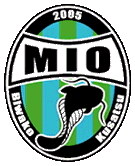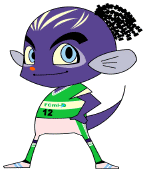Mio Biwako Kusatsu
|
Mio Biwako Kusatsu, located in Shiga Prefecture, has a very interesting history which offers an interesting insight into the creativity that local football fans are exercising in their efforts to establish a pro football team. While many clubs in Japan have colorful and complicated histories, Mio Biwako really went the extra distance to try to bring professional football to Kusatsu at the earliest opportunity. The club traces its most direct historical line to a club formed by U-12 and U-10 soccer players in the city of Kusatsu. The club, which took the name "FC Mi-O Catfish" was fairly successful, winning many youth competitions in the area. Since there was no J.League or JFL team in the area until very recently (when Sagawa Kyubin Tokyo and Sagawa Kyubin Osaka merged to form Sagawa Shiga), as the kids got older they established teams for higher age groups, generating both a trend of growth and a fairly reliable base of fans, drawn from the parents of kids that had played for one of the Catfish teams. By the early 00s the team -- now known as Mi-O Catfish Kusatsu -- had teams running from elementary school age up to the U-16 level In 2005 some of these parents, as well as local business leaders with an interest in forming a local club for adults and perhaps building it into a professional team one day, got together to discuss the various options. Forming an entirely new club would not only require a great deal of organizational skill and money, but also a lot of time. A new team would have to enter the football heirarchy at the very lowest level, and even if it was extremely competitive, several years would be needed to climb through the various levels of the City, Prefectural and Regional league structure. At this point, a young man from Kusatsu spoke up and mentioned that the team he had played for -- Sagawa Kyubin Kyoto -- was at that very moment pondering its future. With the two largest clubs in Sagawa Kyubin's network of company teams, Osaka and Tokyo, preparing to merge, create a massive JFL club, and move in right next door to Kyoto. There would no longer be any point in the Sagawa organization operating an ADDITIONAL team in Kyoto. Since Sagawa Kyoto already held a berth in the Kansai Regional League, they were just a few steps down the ladder from potential J.League status! |
A series of discussions between FC Mi-O Catfish officials, Sagawa Kyubin company managers, players and interested fans followed, and an agreement was reached whereby Mi-o Catfish Kusatsu (the youth team) acquired Sagawa Kyoto (the adult team) and moved it to Kusatsu, while retaining most of the players. Most importantly, Mi-o inherited Sagawa Kyoto's berth in the Kansai League. In January 2006, the newly formed FC Mi-O Biwako Kusatsu settled down in its new home, in Kusatsu city, where it promptly claimed a second-place finish in the Kansai Regional League. The club took its name from Lake Biwa (Biwa-ko, in Japanese), on whose shores the town of Kusatsu is situated.
The following year the club again performed well, and earned a spot in the Nationwide Regional Leagues Championship Tournament. Though Kusatsu finished in third place, the elevation of two teams (Roasso Kumamoto and FC Gifu) from the JFL to the J2 opened up enough space for FC Mi-O to claim a berth in the JFL. To mark its promotion the club dropped the "FC" and the awkward-looking hyphen from Mio, adopted new logos, mascots and uniforms, and began its JFL career as Mio Biwako Kusatsu.
The subsequent histories of the "semi-professional" Mio Biwako and the fully amateur Sagawa Kyubin FC serves as a very telling case study in how Japan's football landscape changed in the first two decades of this millennium. Sagawa Kyubin had a long and very illustrious history as a company team -- or actually, as the paragraphs above describe, a whole bunch of company teams. Sagawa Kyoto provided the base for Mio Biwako, while Sagawa Osaka and Sagawa Tokyo were members of the JFL going back to the 1990s, and their merger produced one of the strongest fully amateur teams in the country. Throughout the '00s, Sagawa Kyubin FC vied with Honda and Sony Sendai for the status of most competitive amateur team in the country. But because the JFL was swamped by an influx of teams that were professional in all but name, Sagawa had little hope of ever winning a JFL title. By contrast, Mio Biwako was an upstart with little history and meagre resources relative to other JFL clubs, but because they were operating as a semi-professional organization, they did not need to worry about justifying their existence to shareholders of the parent company.
In 2012, Sagawa FC finally reached the point where the profit-oriented management of Sagawa Kyubin was no longer willing to foot the bill for their team. Despite finishing high in the standings for several years in a row, there was little chance of them winning the JFL title, because this "amateur" league was now dominated by all-but-fully professional teams. The company dissolved Sagawa FC in what amounted to a public act of suicide, leaving Mio Biwako as the last remaining legacy of the once-proud Sagawa organization.
Fortunately for all concerned, Sagawa's sacrifice was not in vain. It provided the final nudge the J.League needed to introduce a third division (the J3) in 2014, and to make a more permanent separation between the J.League and the amateur ranks. Though teams like Mio Biwako remain in a "grey zone" between pro and amateur status, once the Catfish have built a solid enough foundation to survive as a fully professional organization, they will move on into the J3. In the mean time, they can enjoy the thrill of amateur competition, with most players holding down separate jobs (at least part time) but with a chance to promote their own careers as footballers by contributing to Mio's success on the pitch.
Mio Biwako still seems to be a few years away from making that move. The fan base is not large enough to support acquisition of top-level players, and their corporate backing is also rather weak. However, the team clearly is the most likely candidate to bring J.League excitement to Shiga Prefecture. It will not be long before the J.League can tick off another region, as they pursue the Hundred Year Plan's goal of having a club in every prefecture.





